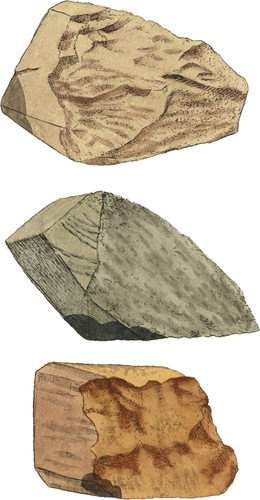 Enlarge
Enlarge
British Mineralogy
Brown Clay
- Class 2. Earths.
- Order 2. Mixed.
- Gen. 2. Pulverulent Quartz.
- Spec. 1. Mixed with Argilla.
- Syn.
- Potters Clay. Kirw. 1. 180.
- Clay. Bab. 50.
- Argile glaise. Haüy, 4. 442.
- Loam, Potters Clay, Pipe Clay, and Variegated Clay. Jameson, 1. 301.
Bricks, tiles, pans, and garden pots are most commonly made of these brown Clays, which do not differ much in quality. The lighter brown Clays generally make the lightest-coloured bricks, their texture chiefly depending on the sand. The common brown Clays are preferred for modelling at the Royal Academy, &c. The upper figure represents a specimen of good red brick Clay, which was found 85 feet below the surface of the ground in Richmond Park. Sometimes the beds of Clay lie more in strata than, at others, and when out of their places separate in a slaty manner. A specimen found at 138 feet of depth at the same place, is something in this manner—see the middle figure—which is rather grayer-coloured and more sandy, and is generally called Blue Clay; taking its name from the blue cast it has when fresh dug. This probably proceeds from the blue or gray Oxide of Iron, which soon bleaches. I have seen it where there have been rifts, allowing passage for water, when, in the parts where the light did not enter, it has shown the most vivid Prussian blue and purplish tints; but these on exposure to light passed off in a few minutes. All wet substances are darker than dry ones; but in these it is most remarkable—see the darker blotches on the left hand of the figures. The lower figure is a sort of Clay, which generally has more or less red or reddish brown sand in it, and is used in great quantities for making coarser pans, garden pots, &c, It is little else than a stiff loamy Earth of the farmers, when it is too coarsely mixed with gravel for the potters, which at the same time is convenient for the purpose of the former, and helps to separate it for the growth of plants. A little addition of common gravel might sometimes greatly help such a soil, and be a little saving as to the quantity of Lime. Good oak lands are nearly of this nature.

